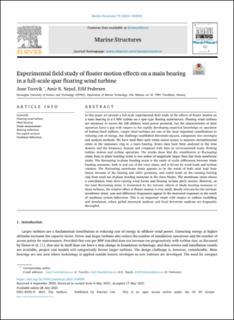| dc.description.abstract | In this paper we present a full-scale experimental field study of the effects of floater motion on a main bearing in a 6 MW turbine on a spar-type floating substructure. Floating wind turbines are necessary to access the full offshore wind power potential, but the characteristics of their operation leave a gap with respect to the rapidly developing empirical knowledge on operation of bottom-fixed turbines. Larger wind turbines are one of the most important contributions to reducing cost of energy, but challenge established drivetrain layouts, component size envelopes and analysis methods. We have used fibre optic strain sensor arrays to measure circumferential strain in the stationary ring in a main bearing. Strain data have been analysed in the time domain and the frequency domain and compared with data on environmental loads, floating turbine motion and turbine operation. The results show that the contribution to fluctuating strain from in-plane bending strain is two orders of magnitude larger than that from membrane strain. The fluctuating in-plane bending strain is the result of cyclic differences between blade bending moments, both in and out of the rotor plane, and is driven by wind loads and turbine rotation. The fluctuating membrane strain appears to be the result of both axial load from thrust, because of the bearing and roller geometry, and radial loads on the rotating bearing ring from total out-of-plane bending moments in the three blades. The membrane strain shows a contribution from slow-varying wind forces and floating turbine pitch motion. However, as the total fluctuating strain is dominated by the intrinsic effects of blade bending moments in these turbines, the relative effect of floater motion is very small. Mostly relevant for the intrinsic membrane strain, sum and difference frequencies appear in the measured responses as the result of nonlinear system behaviour. This is an important result with respect to turbine modelling and simulation, where global structural analyses and local drivetrain analyses are frequently decoupled. | en_US |

